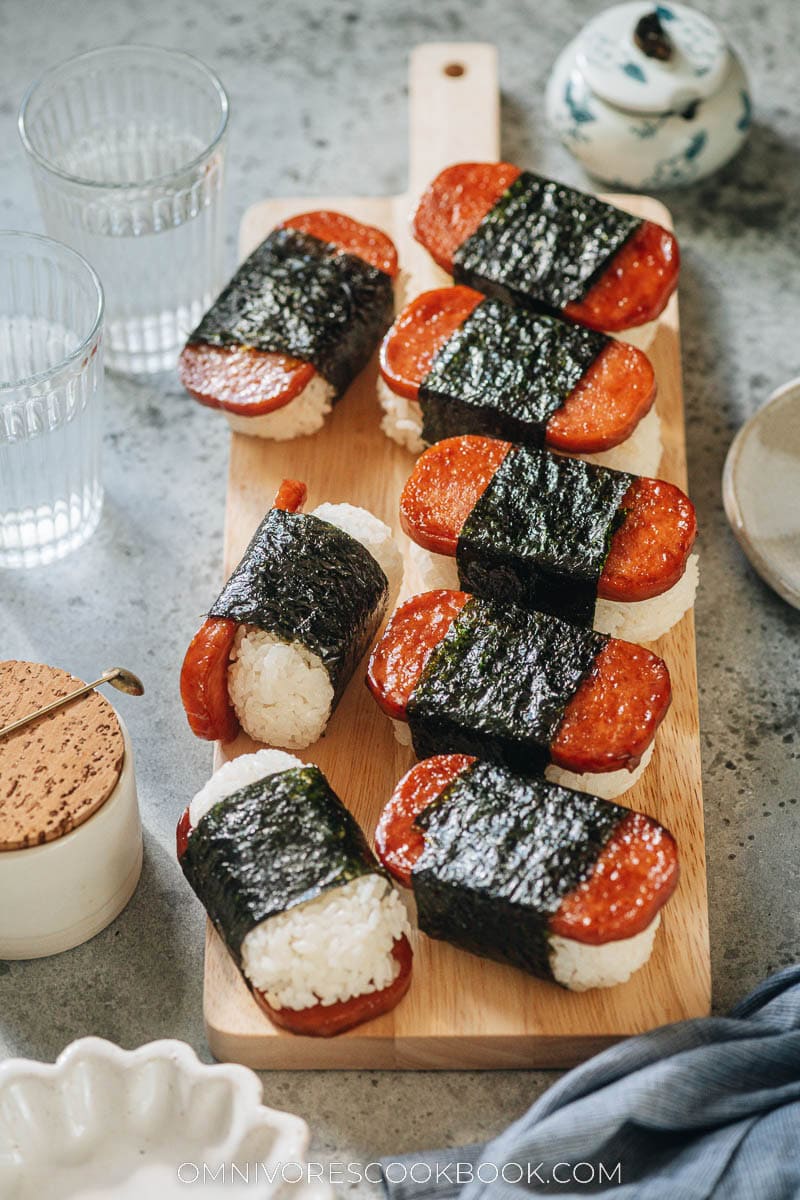
Spam & Chinese cooking
The word Spam might make you think of high-sodium military rations. But in China, Spam is a popular ingredient that people use in comfort food. Spam and pepper stir fry, Spam omelet, Spam ramen, Spam fried rice, or Spam sandwich. You name it.
Spam is also a common ingredient in Chinese Hot Pot and Sichuan Mala Dry Pot – a popular type of Chinese restaurant where you choose a spicy sauce and various ingredients that are cooked in it and then everything is served in a big pot. Every time I go to Mala Pot restaurants with friends, I remember to order a few slices of Spam and it’s always the most popular ingredient in the pot.
Spam is so intertwined with Chinese food culture that I’d never considered Spam a foreign food until I moved the US. Then I started to wonder when it came to China.
After some digging, I found out the following. According to Wikipedia:
“In China, Hormel decided to adopt a different strategy to market Spam, promoting it as a foreign, premium food product and changing the Spam formula to be meatier in order to accommodate local Chinese tastes.”
Apparently, Hormel also decided to name it “luncheon meat” (午餐肉) instead of Spam, to make it sound glamorous. No wonder. Back in old days, Spam was considered a fancy thing that people would serve for dinner on Chinese New Year.
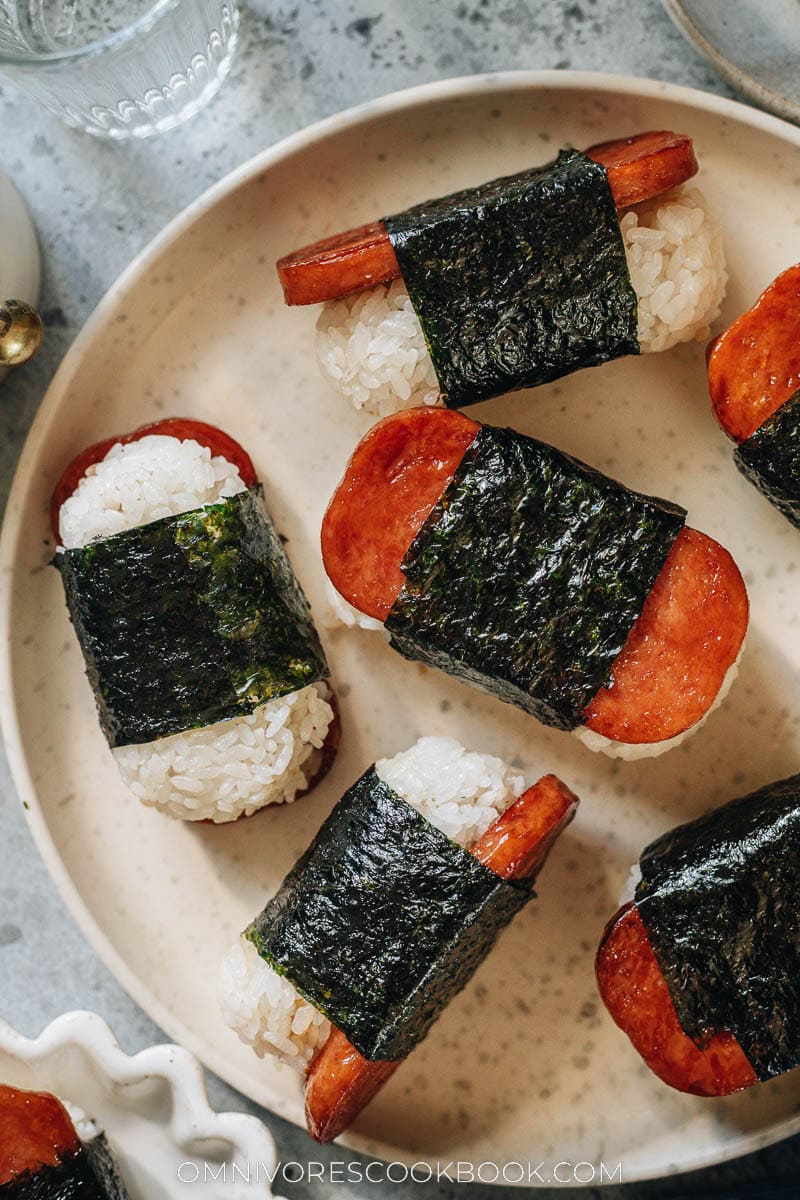
A Common Table Cookbook
This spam musubi recipe is slightly adapted from one in the cookbook A Common Table – 80 Recipes and Stories from My Shared Culture, written by my friend Cynthia Chen McTernan, who is the author behind the award-winning blog Two Red Bowls.
I decided to share her Spam Musubi recipe – a great representation of how Asian food inspired local cuisine and became a part of its culture. Even though I got to know this Hawaiian dish only after moving to the US, it makes me feel nostalgic because of the use of Spam, an ingredient that reminds me of time spent with family and friends.

Spam musubi Ingredients
You only need a few very simple ingredients to make spam musubi:
- Cooked rice
- Spam (I prefer the low sodium type)
- Strips of crispy seaweed (nori)
- Soy sauce and sugar for seasoning
Experiment with sushi rice
The original Hawaiian spam musubi does not use sushi rice, which has added rice vinegar and sugar. But when I make my own spam musubi, I always use sushi rice. The refreshing acidic note cuts the greasiness of the Spam, mellows its saltiness, and works perfectly with the sweet taste.
If you’re feeling adventurous, use the sushi rice recipe from Just One Cookbook. The extra 5 minutes is definitely worth it. Her recipe includes a rice cooker version. Check out this post if you need a detailed instruction on how to make rice on the stovetop.
Seaweed (nori)
Make sure you get the large nori sheet that is about 8” (20 cm) to 9” (22 cm) long. It is usually labeled as sushi nori, yaki nori (roasted seaweed), or laver for Gimbap (if you visit a Korean store). They usually come in large, thin, square packages. And you will need to cut them into strips for this recipe.
How to make spam musubi
Cook the Spam
- Brown the spam until crispy
- Braise the spam with sugar and soy sauce, until the surface is caramelized
It’s very important that you brown the spam slowly and thoroughly. It renders some fat and makes a very crispy crust. Then you will use some sugar and soy sauce mixed with water to quickly braise the Spam. You will end up with a beautifully caramelized dark brown surface that is still chewy and sticky. It’s perfect.

Wrapping the spam musubi
- Place a strip of nori sheet on your working surface, then place the spam at the very end
- Make a ball of rice by pressing it together, then shape it into an oval shape that is similar to the sliced spam
- Roll up the spam and rice using the nori strip
- Make sure to tuck the rice tight enough so the musubi doesn’t fall apart, but not too tight that you tear the nori sheet
- Smear the end of the nori sheet with a bit of water and roll up the musubi, so the nori will stay put.
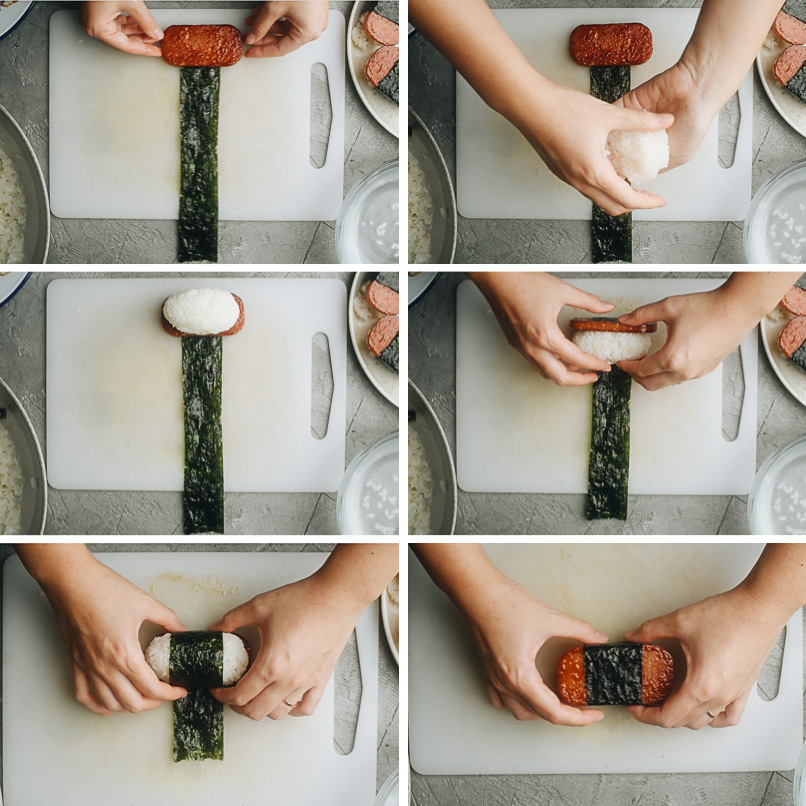
Tips on shaping the rice
You can use a musubi mold to make the rice pressing process much easier and less messy. I only included the traditional way in the recipe, where you use your hands to press the rice. If you like to DIY, you can even use a Spam can to make your own musubi mold (you need to remove the bottom of the can and cut the can a bit shorter).
To make sure the rice doesn’t stick to your hands too much, make sure to always wet your hands before rolling each musubi.
When you press the rice by hand, it’s important to use proper strength so that the rice is pressed together but not overly mashed. If you don’t press enough, the musubi might fall apart when you bite into it. If you press too hard, the rice texture will be too dense. It takes a bit of practice but once you make a few musubi, you’ll get the idea.
How to store and reheat spam musubi
Spam musubi will taste the best when it’s freshly made and you can appreciate the crunchy spam, tender rice, and crispy seaweed. If you serve it within a couple of hours, it’s OK to store them in a container at room temperature. For longer storage, you need to store them in the fridge. If you store them in the fridge, you should always reheat the musubi in a microwave to warm up the rice, to avoid a tough texture.
I’ve not tried freezing spam musubi, but I think it’s totally OK. You should thaw the frozen musubi in the fridge completely, and reheat them before eating.
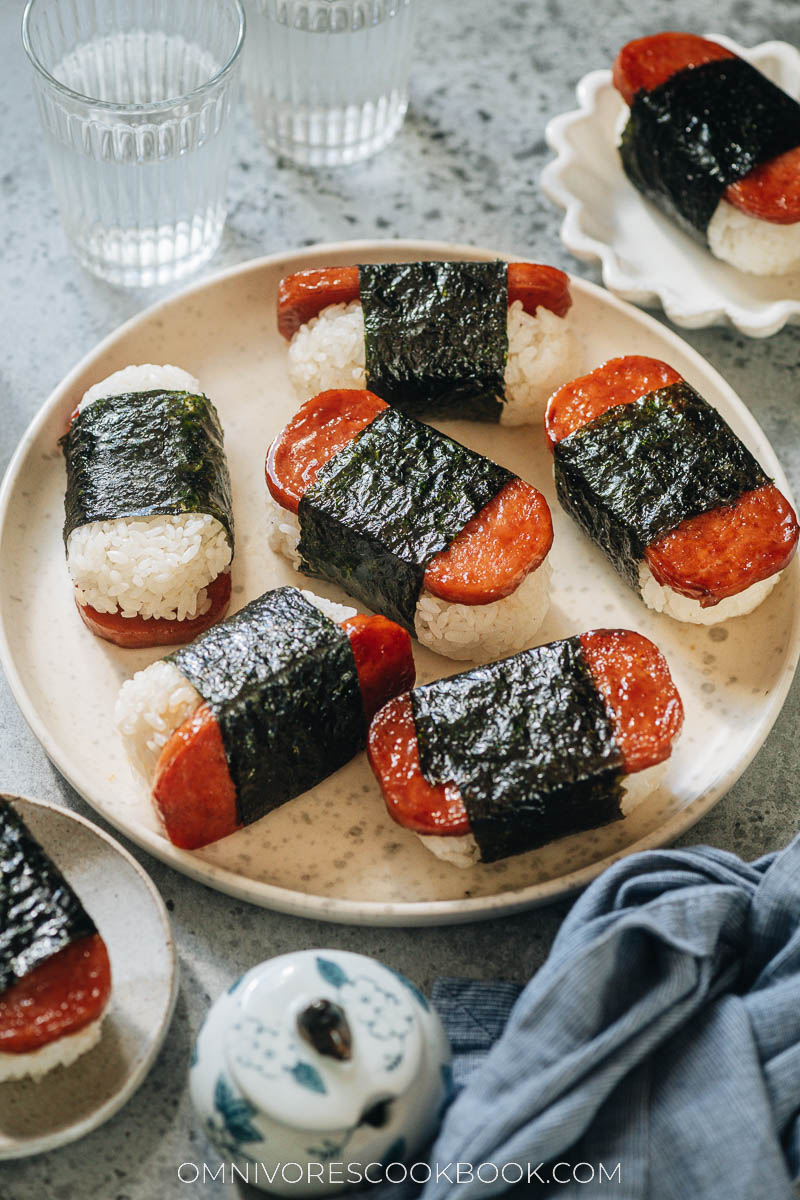
More delicious recipes for your next party
- Air Fryer Chinese Chicken Wings
- Curry Egg Salad Wonton Cups
- Pork Lettuce Wrap (San Choy Bow)
- Old-Beijing Fried Carrot Fritters (炸素丸子)
- Chinese Fried Stuffed Eggplant (炸茄盒, Zha Qie He)
This spam musubi recipe is slightly adapted from the cookbook A Common Table – 80 Recipes and Stories from My Shared Culture, written by my friend Cynthia Chen McTernan
Chinese Cooking Made Easy
Are you new to this website? This free email series is a great place to start. I’ll walk you through a few of my most popular recipes and show you how and why they work. You’ll quickly start to cook better Chinese food in your own kitchen.
Watch video
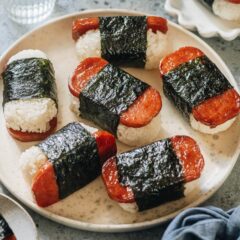
Barter-Worthy Spam Musubi
Ingredients
- 1 teaspoon vegetable oil
- 1 can low-sodium Spam (12 oz. / 340 g can) , sliced into 8 pieces
- 1/4 cup water
- 2 teaspoons soy sauce
- 2 tablespoons sugar
- 4 cups cooked sushi rice (or regular cooked short grain white rice) (*Footnote)
- 3 sheets roasted seaweed (nori) , cut into 8 strips about 2” (5 cm) wide and 9” (23 cm) long
Instructions
- Start making steamed rice (or sushi rice) if you don’t have any already made.
- Heat the oil in a 12-inch (30cm) nonstick or well-seasoned cast-iron skillet over medium heat. Add the Spam slices and cook until browned and crispy on the bottom side, 2 to 3 minutes. Flip and cook until the other side is also browned and crispy, 2 to 3 minutes.
- Whisk together the water and soy sauce in a small bowl. Sprinkle the sugar evenly over the Spam slices, then add the soy sauce mixture. Swirl to evenly distribute, then let the Spam simmer until the liquid is nearly absorbed, 3 to 4 minutes. Flip once in between, so the sugar will melt completely and camalize well. Transfer the Spam slices to a plate to cool.
- To make the sushi: Place one slice of Spam perpendicular to the nori strip on the bottom of the strip (forming a cross shape). Wet the palms and fingers of both of your hands, measure 1/2 cup of rice, and transfer the rice to your palm. Use both hands to firmly press the rice into a ball. Then hold the rice ball with your left hand, with your thumb and the other four fingers to secure both sides, use your right hand to gently press the rice ball into a rectangular shape about the size of the Spam slice. Place the rice on top of the Spam. Roll up the Spam and rice so that the nori sheet wraps around it. Seal the end with a bit of water and place the musubi seam-side-down while you work on the rest. Repeat with the remaining nori strips, Spam slices, and rice. Remember to rinse your hands every time, to minimize rice sticking to your hands.
- Enjoy the spam musubi immediately at room temperature. You can store them in an airtight container or wrap them with plastic wrap and place them in the fridge. To serve refrigerated musubi, warm them in the microwave for 20 seconds or so, to get the best texture.
Notes
- A couple of notes on the rice:
When making sushi rice, always use short grain rice. Medium and long grain rice are less starchy and don’t hold together well when pressed into sushi or musubi.
The original recipe uses regular steamed rice, and so do most Hawaiian Spam musubi recipes.
However, I personally prefer making sushi rice, which contains rice vinegar and sugar. The acid and mild sweetness of the sushi rice complement the salty Spam and create more depth of flavor.
You will use about 3 1/2 cup to 4 cups of cooked rice for this recipe. I found my personal favorite ratio is: slice the Spam into 8 slices, and use 1/2 cup of cooked rice per musubi. In my case, I used 4 cups of cooked sushi rice, which were yielded from 2 rice-cooker cups (180ml per cup) of raw short grain rice.
Nutrition

Did you make this recipe?
I’d love to hear how it turned out for you! Please take a moment to leave a 5-star rating ⭐️ and share your thoughts in the comments further down the page. It really helps others discover the recipe too.

Elizabeth
My fave for lunar new year is bing pi yue bing. It’s kinda complex for me but a good challenge.
Goal for this coming year: make it more edible next year lol!
John
Looks good!
My favorites: shao mai, mapo tofu
Steph
I love congee
Andy Dyer
I like making spring rolls. I’d like to make my own noodles someday. I’m definitely going to try spam musubi. Thanks for the contest!
Anthony Ramanauskas
A. couple of go to favorites are Mapo Tofu , Mongolian Beef and Singapore Noodles.
Tom Ging
Maggie,
I enjoy reading your blog. Your recipes are close to what I call “Chinese Soul food”. In subsequent emails I’ll send pictures of some of my preps of your recipies. – – tg
Renee
I love Asian food way too much to narrow it down to just a few favourite dishes. But because I have a trip to Hong Kong coming up, I’ll say one of my absolute favorite Asian dishes is the fried pork buns at Tim Ho Wan in Hong Kong. Oh my goodness they are what dreams are made of.
This recipe looks delicious. I think spam is stupid tasty so I am definitely gonna try it sometime!
Barbara Wright
I love making homemade potstickers.😊❤😊
Nicole Pavo
I’ve made many of your dishes but my favorite has to be the beef noodles that you make with hamburger & 2 beef saimin packets. It’s my favorite because this recipe I’ve made the most, its quick & easy to make, & all my 3 boys just love it!! They devour it in seconds lol! Thank you for all your great recipes, it has helped with ideas of quick meals & also helped me tap back in to how fun cooking can really be & trying new things! I just bought all the stuff to make musubis just last night & excited to try your recipe. I grew up in Hawaii so these were always around. I always get really excited when I see your posts & look forward to making your recipes. Thanks again Maggie!
Lina W (linaribena)
My absolute favourite dish is Fujianese noodles from my parents home town 🙂 its thick noodles paired with fresh seafood straight from the sea tastes amazing and always brings me happy memories from my childhood! Have you tried it before?
Auntie Marcia
LOVE your website and recipes! We just came back from living in China and all these recipes are really authentic to my experience. Thanks, Maggie, for keeping us up on so many great authentic recipes! I certainly know where to go to find those Chinese goodies I crave!
Gretchen
This is a dish a college roommate introduced me to and have thought about it ever since (over 15 years). I also really enjoy Japanese cheesecake and Malai kofta.
Cindy
I love curry laksa with egg noodles!!! 😍
Lina W (linaribena)
My absolute favourite Asian dish is Fujianese noodles from my parents home town 🙂 The thick noodles paired with assorted seafood fresh from the sea tastes amazing and always brings me happy memories of my childhood.
Chau
Love spam
Fried rice
Will need to try this recipe
Christina
I love Chinese hot pot
Or any stir fry
Srijani Bhattacharya
I love any food Asian! Be it dumplings or stews or one pot dishes. I love the rice based dishes the most though.
An ardent rice lover that I am 😋
Sherrie
I love Cha Shu and I have yet to find the perfect Cha Shu recipe. So for me fried rice with Cha Shu is the best for me. (oh, I did try yours and I am happy. But still looking for that perfect cha shu recipe). Also as for spam musubi, I like my rice plain so the spam with the teriyaki sauce can favor the whole rice. (I guess that’s how my husband’s cousin show me how to do that – she is from Hawaii).
Della Fok
Love love love GON CHOW NGAU HO ( stir fried beef rice noodles)! Always reminds me of growing up in LA and going to HK style cafes with my parents , or even better, when we visit family in Hong Kong. Thanks for sharing your blog and feed with us on insta,! Long time follower but first time commenter — love your recipes and your photos so much!
Tammie
My favorite dishes are Szechuan green beans and hand shredded cabbage. The cabbage I fell in love with while teaching English in China last summer.